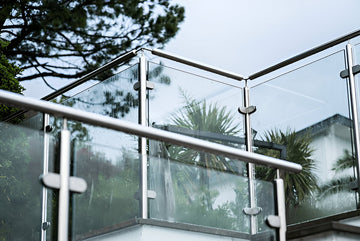Glass Balustrade Fixing Components: A Guide to Clamps, Brackets & Posts
by Saman Mojab on Jul 28, 2025

Modern architecture values openness, light, and simplicity—qualities that glass balustrades embody perfectly. Whether installed on balconies, staircases, terraces, or mezzanines, glass balustrades add a clean, contemporary edge while maintaining essential safety standards. However, what often goes unnoticed in these transparent systems is the precise engineering behind their installation. This is where glass balustrade fixing components come into play.
The visible elegance of glass balustrades depends entirely on the performance of hidden (or discreet) elements like clamps, brackets, and posts. These fittings ensure each panel remains firmly in place under pressure, movement, and time. Choosing the right fixing components directly impacts not only safety but also the lifespan and aesthetic of the installation.
At Quality Glass Fittings Ltd, industry professionals and discerning homeowners alike will find a wide range of premium balustrade hardware—from D-type and square clamps to brushed stainless posts and architectural-grade glass connectors. This guide explains the function and selection of each of these core components so that every balustrade, whether frameless or post-supported, delivers strength, compliance, and style in equal measure.

Glass Clamps: Types, Functions & Where to Use Them
Glass clamps are one of the most important components in a balustrade system. Their purpose is to grip glass panels securely—usually without the need to drill through the glass—while allowing a clean, frameless appearance. They form the key link between the glass and structural elements such as posts or walls, enabling both strength and seamless design.
Types of Glass Clamps
At Quality Glass Fittings Ltd, various styles of glass clamps are available to suit different structural requirements and design preferences:
- D-Type Clamps: These have a rounded profile and are commonly used with tubular posts. Ideal for domestic balconies and exterior railings where a soft-edge aesthetic is preferred.
- Square Clamps: Featuring straight edges and a geometric profile, square clamps suit contemporary spaces with angular lines—frequently used in commercial installations.
- Wall-Mounted Clamps: Designed to secure glass panels directly to vertical surfaces, these clamps eliminate the need for posts and are perfect for end panels in staircases or landings.
- Adjustable Clamps: These allow the installer to fine-tune the position or angle of the glass, especially helpful on uneven floors or angled installations like staircases.
Each type is compatible with glass thicknesses from 8mm to 12mm, and comes with internal rubber gaskets to protect the glass surface and prevent slippage. Many models also feature safety pins or grub screws for extra locking strength.
Where to Use Them
Glass clamps are typically used in:
- Frameless or semi-frameless staircases
- Glass balcony systems
- Pool fencing and terrace barriers
- Commercial partitions and atriums
When chosen correctly, they contribute not just to safety but to the overall minimalism of a space. A matte black square clamp, for example, can become an intentional part of the design, matching handrails and door fittings throughout the property.
Balustrade Posts: Styles, Strength & Mounting Options
While frameless systems are highly sought-after, many residential and commercial balustrade installations still rely on balustrade posts as structural anchors. These vertical components not only support glass panels but also define the layout, spacing, and load-bearing capacity of the entire system. Choosing the right type of post is crucial—both for performance and aesthetics.
Styles of Balustrade Posts
At Quality Glass Fittings Ltd, a wide range of post designs is available to meet diverse architectural needs:
- Round Posts: The most common profile, offering a timeless and adaptable look. Ideal for staircases, balconies, and pool fencing.
- Square Posts: Sharp-edged and modern, square posts pair well with minimalist interiors or commercial applications.
- Slotted Posts: These feature an integrated vertical channel designed to hold glass panels directly—eliminating the need for clamps and delivering a streamlined profile.
- Pre-Assembled Posts: Supplied with clamps and handrail brackets already attached, these posts speed up installation and reduce alignment errors on-site.
Posts are typically manufactured from 304 stainless steel for indoor use and 316-grade stainless steel for external environments such as coastal areas or poolside applications. The higher grade offers superior resistance to corrosion and is recommended wherever prolonged exposure to moisture is expected.
Mounting Options
There are three primary ways to fix posts depending on the surface type and design intent:
- Surface Mounting (Base Plate): The post is anchored directly to the flooring with visible fixings, often concealed by a decorative cover plate.
- Core Drilling: The post is inserted into a hole in concrete or stone and secured with grout or resin—offering a cleaner finish with no base plate visible.
- Fascia Mounting (Side Fix): The post is attached to the side face of a balcony or staircase, saving floor space and delivering a floating glass effect.
Each mounting method must be chosen based on structural requirements, space constraints, and desired visual impact. For example, fascia mounting is excellent for narrow balconies where surface space is limited.

Glass Brackets & Connectors – Frameless Precision
In truly frameless glass balustrade systems, where posts and clamps are minimized or eliminated altogether, the spotlight shifts to glass brackets and connectors. These small yet powerful components are engineered to join glass panels precisely and securely—either to one another or to adjacent architectural elements like walls or columns. When installed correctly, they enable structural integrity while preserving the illusion of uninterrupted transparency.
Types of Glass Connectors & Brackets
Quality Glass Fittings Ltd supplies a full range of glass-to-glass connectors and brackets, suitable for a variety of frameless and semi-frameless applications:
- Inline Connectors: Join two glass panels in a straight line. Commonly used in long balustrade runs, shopfronts, or partition walls.
- 90° Corner Connectors: Create a clean right-angle connection—ideal for L-shaped balconies or landings.
- 135° Angle Connectors: Used in angled staircases or custom geometry where glass panels need to meet at obtuse angles.
- T-Connectors: Facilitate perpendicular intersections, often used in commercial layouts with multiple glass segments.
- Wall Brackets (Wall-to-Glass Fixings): Secure glass panels directly to fixed surfaces like concrete, wood, or steel columns without requiring posts.
- Glass Standoff Brackets: Cylindrical spacers that hold the glass slightly off the mounting surface, offering an elegant floating effect—commonly seen in signage or staircase infills.
Each bracket is crafted from high-grade stainless steel or solid brass and comes in finishes like brushed satin, polished chrome, or matte black to match the rest of the hardware. Most connectors include internal rubber pads or gaskets to protect the glass from metal-to-glass contact and reduce vibration.
Why Precision Matters
Poor alignment between panels—even a few millimetres off—can lead to uneven gaps, inconsistent sightlines, or stress fractures over time. That’s why choosing precisely machined connectors is essential. With Quality Glass Fittings’ laser-cut and CNC-machined brackets, you ensure not only structural stability but also perfect panel alignment—delivering that seamless frameless look your design calls for.
Choosing the Right Finish & Material
Beyond strength and function, the material and finish of glass balustrade fixing components play a major role in long-term durability, safety, and visual appeal. The wrong choice can lead to corrosion, discoloration, or aesthetic mismatch, particularly in outdoor or high-humidity environments. Selecting the correct material specification ensures that your system not only performs flawlessly but also looks refined and cohesive across every component.
Material Options
At Quality Glass Fittings Ltd, balustrade components are manufactured using premium materials that suit a range of installation environments:
- 304 Stainless Steel: Ideal for indoor applications, such as staircase balustrades or interior mezzanines. Offers solid corrosion resistance and a cost-effective balance of strength and finish quality.
- 316 Stainless Steel: The industry standard for outdoor, coastal, or poolside environments. With added molybdenum, it offers superior resistance to salt, chlorine, and harsh weather conditions. This is the recommended choice for long-term performance in exposed settings.
- Solid Brass: Preferred in luxury interiors where custom finishes (such as antique brass, satin gold, or PVD bronze) are required. While not as corrosion-resistant as stainless steel, brass excels in stylistic flexibility.
- Aluminium (coated): Lightweight and often powder-coated for color versatility, aluminium is generally reserved for non-structural brackets or decorative trims.
Finish Options
- Brushed (Satin) Finish: A popular matte look that hides fingerprints and blends seamlessly with most contemporary designs. Ideal for both commercial and residential projects.
- Polished (Mirror) Finish: Highly reflective and decorative. Best used indoors or in premium showpiece areas where the hardware doubles as a design element.
- Matte Black: A rising trend in industrial, minimal, and Scandi-style interiors. Often chosen for contrast or to match black-framed glazing systems and door hardware.
- PVD Coated Finishes: Includes brass, bronze, and gunmetal tones. Offers decorative impact with enhanced surface hardness and scratch resistance.
Tips for Material & Finish Selection
- Match all hardware (posts, clamps, brackets) in both material and finish to maintain visual harmony.
- For wet zones, never compromise—opt for 316 stainless steel, even on small components like wall brackets.
- If choosing black or brass finishes, consider coordinating with nearby elements such as handrails, door handles, or shower hardware for a unified look.

Installation Best Practices for Fixing Components
Even the most premium glass balustrade fixing components—whether clamps, posts, or brackets—can underperform or even fail if installed incorrectly. From structural alignment to surface prep and torque settings, the installation phase is where the performance, safety, and appearance of the entire system is decided. Below are the best practices recommended by professionals and supported by Quality Glass Fittings’ product standards.
1. Verify Substrate Strength & Level
Before installation begins, ensure that the mounting surface (floor, wall, or fascia) is:
- Structurally sound (concrete, steel, or reinforced wood)
- Free of dust, grease, and moisture
- Properly levelled or aligned using laser or string line guides
This is especially important when installing core-drilled posts or wall brackets, where hidden misalignment can lead to visible issues.
2. Use Compatible Fixings for Glass Thickness
Fixing components should always be matched to the exact thickness of the glass (typically 8mm, 10mm, or 12mm). A mismatch can result in loose panels, unsafe gaps, or excess pressure that may cause breakage.
🔧 Example: A clamp rated for 12mm glass with undersized glass can’t achieve sufficient grip, even if the screw is tightened fully.
3. Incorporate Rubber Gaskets or Plastic Spacers
All clamps, brackets, and connectors must include rubber pads or gaskets. These:
- Prevent direct metal-to-glass contact
- Absorb vibration and movement
- Distribute stress evenly across the panel
Most products from Quality Glass Fittings are supplied with matching gaskets designed for their specific use and glass thickness.
4. Use the Correct Torque & Anchors
- Avoid overtightening clamp screws; use a torque driver or Allen key and follow manufacturer guidelines.
- Use stainless steel anchors or fixings appropriate for the surface (e.g. chemical anchors for concrete, timber bolts for wood).
- For wall-mounted systems, use multiple anchor points and check spacing against glass panel height and weight.
5. Maintain Consistent Panel Gaps
Keep uniform spacing—typically 20–25mm between glass panels—for aesthetic consistency and to accommodate thermal expansion. Uneven gaps create tension points that may lead to future alignment issues.
6. Seal Exposed Edges in Exterior Installs
For balconies, terraces, or pool fencing:
- Apply clear structural silicone around base plates or core-drilled entry points to prevent water ingress.
- Seal all exposed stainless components using anti-corrosion spray or wax polish, especially in coastal zones.
Conclusion
Whether you're building a luxury staircase, a frameless balcony, or a poolside enclosure, the success of your glass balustrade system depends on the invisible strength of its fixing components. From structural posts and precise glass clamps to minimalist connectors and architectural brackets, each part plays a role in delivering a safe, stable, and visually seamless installation.
By choosing professionally engineered hardware—like the solutions offered by Quality Glass Fittings Ltd—you ensure not only compliance with safety regulations, but also a finish that aligns with the highest standards of modern design. Matching materials, consistent finishes, and attention to detail all combine to create balustrades that look as good in 10 years as they do on day one.
Whether you’re a contractor, architect, or homeowner managing a custom renovation, this guide should equip you to make informed decisions about balustrade components that are as secure as they are stylish.
FAQs
1. What thickness of glass is compatible with most clamps and brackets?
Most components are designed for 10mm to 12mm toughened glass, though some models support 8mm or 15mm. Always confirm compatibility on the product spec sheet.
2. Should I use 304 or 316 stainless steel?
Use 304-grade for indoor environments and 316-grade for outdoor, coastal, or wet environments due to its enhanced corrosion resistance.
3. Can I install a frameless balustrade without posts?
Yes. Frameless systems can use U-channels, glass-to-glass connectors, or standoff brackets for support. However, this may require more precise alignment and planning.
4. Are gaskets always required?
Absolutely. Gaskets prevent direct metal-to-glass contact, reduce vibration, and distribute load safely across the panel.
5. Where can I purchase professional-grade balustrade fixings?
You can find a complete range of glass clamps, posts, brackets, and connectors at Quality Glass Fittings Ltd.

